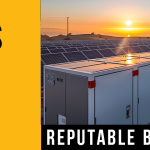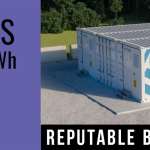 The US government has been urged to recognise the “critical role” energy storage can play in making the grid cleaner and able to accept more renewable energy, by increasing the eligibility of batteries and other technologies to receive the Investment Tax Credit (ITC).
The US government has been urged to recognise the “critical role” energy storage can play in making the grid cleaner and able to accept more renewable energy, by increasing the eligibility of batteries and other technologies to receive the Investment Tax Credit (ITC).
The ITC is applicable to purchases of solar energy equipment in the US and effectively represents a 30% rebate for investors if fully realised. In recent years the policy scheme has been adjusted to include energy storage but for a long time, storage systems could only receive the Federal subsidy if installed at the same time as solar equipment.
However, a bill proposed in 2016 by Senator Martin Heinrich of New Mexico, S.1868, would amend revenue codes to apply either the ITC, similar tax relief measures or include energy stored in batteries, flywheels and pumped hydro in ‘Energy Credits’ policies. Heinrich’s “Energy Storage Tax Incentive and Deployment Act of 2017″ would therefore see storage units rewarded for the energy they put into service on the grid and now has 11 co-sponsors from the Senate.
Yesterday, a joint letter was sent by the national Energy Storage Association (ESA), Solar Energy Industries’ Association (SEIA), American Wind Energy Association (AWEA), Advanced Energy Economy (AEE), National Electrical Manufacturers’ Association (NEMA), National Hydropower Association, Clearpath Action and Citizens for Responsible Energy Solutions urging Congress to support these actions.
Addressed to Paul Ryan, Speaker of the House along with Senate Majority Leader Mitch McConnell, Minority Leaders Nancy Pelosi and Charles Schumer, the groups urged Congress to include clarification of the ITC issue as pertains to energy storage as eligible under two tax codes, Sections 48 and 25. Referring to the bicameral and bipartisan support of the 11 co-sponsors, the authors described S.1686 as a “common-sense bill” which would “ensure a level playing field” for storage to compete with other ITC-eligible resources.
“Without clear statutory rules, energy storage industry members face continuing uncertainty from IRS guidance about the eligibility of energy storage equipment for Section 48 and 25 tax credits when paired with ITC-eligible resources,” the letter stated.
read more
 Solartech Indonesia 2019 and Energy Storage Indonesia 2019 are the ASEAN’s Largest Trade Show for Solar PV & Energy Storage Technologies. Here, global manufacturers, suppliers, distributors, service providers and partners in the global Solar PV and Energy Storage Technology gather from April 4-6, 2019 at JIExpo Kemayoran Jakarta.
Solartech Indonesia 2019 and Energy Storage Indonesia 2019 are the ASEAN’s Largest Trade Show for Solar PV & Energy Storage Technologies. Here, global manufacturers, suppliers, distributors, service providers and partners in the global Solar PV and Energy Storage Technology gather from April 4-6, 2019 at JIExpo Kemayoran Jakarta. FERC last week granted ISO-NE’s request to terminate the capacity supply obligation (CSO) for Invenergy’s delayed 485-MW Clear River Energy Center Unit 1, while also denying the developer’s request for a Tariff waiver over the matter (ER18-2457).
FERC last week granted ISO-NE’s request to terminate the capacity supply obligation (CSO) for Invenergy’s delayed 485-MW Clear River Energy Center Unit 1, while also denying the developer’s request for a Tariff waiver over the matter (ER18-2457). In a letter filed Nov. 26, the Solar Energy Industries Association (SEIA), alongside a broad coalition of energy trade and advocacy organizations, urges Congress to modify the tax code to include energy storage as an eligible technology for the investment tax credit (ITC).
In a letter filed Nov. 26, the Solar Energy Industries Association (SEIA), alongside a broad coalition of energy trade and advocacy organizations, urges Congress to modify the tax code to include energy storage as an eligible technology for the investment tax credit (ITC). Unveiled today (26 November), the 3MW system will enable Arsenal to cut electricity bills and avoid peak power prices. Developed by Pivot Power, the 3.7MWh system can power the club’s Emirates Stadium in North London for an entire match – equivalent to powering 2,700 homes for two hours.
Unveiled today (26 November), the 3MW system will enable Arsenal to cut electricity bills and avoid peak power prices. Developed by Pivot Power, the 3.7MWh system can power the club’s Emirates Stadium in North London for an entire match – equivalent to powering 2,700 homes for two hours. German frequency response service revenues have dropped almost two-thirds in two years as utilities have rushed to deploy energy storage, research shows.
German frequency response service revenues have dropped almost two-thirds in two years as utilities have rushed to deploy energy storage, research shows. Scale Microgrid Solutions is on a mission to make sophisticated microgrids as easy to deploy and finance as rooftop solar, said Timothy Hade, microgrid specialist for the company.
Scale Microgrid Solutions is on a mission to make sophisticated microgrids as easy to deploy and finance as rooftop solar, said Timothy Hade, microgrid specialist for the company.



